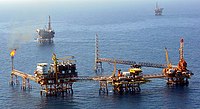
Photo from wikipedia
Field observations require adequate metocean data gathering to promote the link between environmental diagnostic and prognostic obtained from modeling techniques. In general, model confidence can be improved by using data… Click to show full abstract
Field observations require adequate metocean data gathering to promote the link between environmental diagnostic and prognostic obtained from modeling techniques. In general, model confidence can be improved by using data which present better quality and by improved parametrizations. This paper discusses and suggests timing routines for data gathering which are enough to describe the hydrodynamic behavior of estuarine and coastal areas. From the environmental diagnostics viewpoint, a sampling procedure is defined to the temporal scales providing data with adequate resolution to describe the natural process without signal aliasing. The proposed sampling procedure was based on the analysis of a data set of tides, currents, waves, water temperature, and meteorological variables observed at several stations along the Brazilian coast. The instrument setup was based mainly on the results of the harmonic analysis of tides. It is shown that the setup of instruments for simultaneous measurements of currents and waves requires special attention particularly in sites that present low currents and the action of waves. A subset of data gathered in shallow bays was used to estimate the surface turbulent stress by using a classical and a slightly modified parametrization for the wind drag coefficient. Under near neutral atmospheric stability conditions and high tide excursion, the surface turbulent stress obtained with the classical and the modified parametrization differed but the current profiles are expected to be only partially affected by wind-induced drift currents.
Journal Title: Sensors
Year Published: 2020
Link to full text (if available)
Share on Social Media: Sign Up to like & get
recommendations!